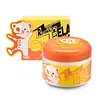What's inside
What's inside
 Key Ingredients
Key Ingredients

 Benefits
Benefits

 Concerns
Concerns

 Ingredients Side-by-side
Ingredients Side-by-side

Swiftlet Nest Extract
Skin ConditioningMacadamia Integrifolia Seed Oil
Skin ConditioningBeeswax
Emulsion StabilisingCetyl Alcohol
EmollientGlycerin
HumectantPolysorbate 60
EmulsifyingDipropylene Glycol
HumectantRetinol
Skin ConditioningSh-Oligopeptide-1
Skin ConditioningSodium Polyacrylate
AbsorbentAllantoin
Skin ConditioningPEG-100 Stearate
Adenosine
Skin ConditioningCarbomer
Emulsion StabilisingBetaine
HumectantPropylene Glycol
HumectantCaprylic/Capric Triglyceride
MaskingPolysorbate 20
EmulsifyingArginine
MaskingAlcohol
Antimicrobial1,2-Hexanediol
Skin ConditioningCeteth-3
EmulsifyingBrassica Campestris Sterols
EmollientTocopheryl Acetate
AntioxidantCetyl Phosphate
EmulsifyingCholesterol
EmollientPEG-5 Rapeseed Sterol
CleansingHydrogenated Lecithin
EmulsifyingEthylhexylglycerin
Skin ConditioningWater
Skin ConditioningSorbitan Sesquioleate
EmulsifyingCeteth-5
EmulsifyingDisodium EDTA
Glyceryl Stearate
EmollientParfum
MaskingSwiftlet Nest Extract, Macadamia Integrifolia Seed Oil, Beeswax, Cetyl Alcohol, Glycerin, Polysorbate 60, Dipropylene Glycol, Retinol, Sh-Oligopeptide-1, Sodium Polyacrylate, Allantoin, PEG-100 Stearate, Adenosine, Carbomer, Betaine, Propylene Glycol, Caprylic/Capric Triglyceride, Polysorbate 20, Arginine, Alcohol, 1,2-Hexanediol, Ceteth-3, Brassica Campestris Sterols, Tocopheryl Acetate, Cetyl Phosphate, Cholesterol, PEG-5 Rapeseed Sterol, Hydrogenated Lecithin, Ethylhexylglycerin, Water, Sorbitan Sesquioleate, Ceteth-5, Disodium EDTA, Glyceryl Stearate, Parfum
Snail Secretion Filtrate
Skin ConditioningBetaine
HumectantCaprylic/Capric Triglyceride
MaskingButylene Glycol
HumectantCetearyl Olivate
Sorbitan Olivate
EmulsifyingCetearyl Alcohol
EmollientCarbomer
Emulsion StabilisingEthyl Hexanediol
SolventPhenoxyethanol
PreservativeArginine
MaskingDimethicone
EmollientSodium Polyacrylate
AbsorbentSodium Hyaluronate
HumectantAllantoin
Skin ConditioningPalmitic Acid
EmollientPanthenol
Skin ConditioningXanthan Gum
EmulsifyingStearic Acid
CleansingAdenosine
Skin ConditioningWater
Skin ConditioningMyristic Acid
CleansingSnail Secretion Filtrate, Betaine, Caprylic/Capric Triglyceride, Butylene Glycol, Cetearyl Olivate, Sorbitan Olivate, Cetearyl Alcohol, Carbomer, Ethyl Hexanediol, Phenoxyethanol, Arginine, Dimethicone, Sodium Polyacrylate, Sodium Hyaluronate, Allantoin, Palmitic Acid, Panthenol, Xanthan Gum, Stearic Acid, Adenosine, Water, Myristic Acid
 Reviews
Reviews

Ingredients Explained
These ingredients are found in both products.
Ingredients higher up in an ingredient list are typically present in a larger amount.
Adenosine is in every living organism. It is one of four components in nucleic acids that helps store our DNA.
Adenosine has many benefits when used. These benefits include hydrating the skin, smoothing skin, and reducing wrinkles. Once applied, adenosine increases collagen production. It also helps with improving firmness and tissue repair.
Studies have found adenosine may also help with wound healing.
In skincare products, Adenosine is usually derived from yeast.
Learn more about AdenosineAllantoin is a soothing ingredient known for its protective and moisturizingg properties. Because of this, it is often added to products with strong active ingredients.
Studies show higher concentrations of this ingredient can promote wound healing.
Though it can be derived from the comfrey plant, allantoin is produced synthetically for cosmetic products to ensure purity.
Learn more about AllantoinArginine is an amino acid that is important for human development. Your body uses is it to produce hair keratin and skin collagen.
As a cosmetic ingredient, Arginine has antioxidant properties and can also help repair damaged skin. This ingredient is derived either synthetically or from animals.
Arginine isn't fungal acne safe when used in the presence of other lipids (fats, fatty acids, oils, esters, etc). Oils and fats occur naturally within the skin, so take caution when using Arginine if you're prone to fungal acne.
Learn more about ArginineBetaine is a common humectant (a substance that promotes retention of moisture). It's known to be gentle on the skin and can help balance hydration.
This ingredient is best for improving hydration and soothing irritated skin. Studies also show it helps even out skin tone.
Fun fact: Betaine is naturally created in the skin and body. The kind found within cosmetic products can be either plant-derived or synthetic.
Another name for betaine is trimethylglycine.
Learn more about BetaineThis ingredient is an emollient, solvent, and texture enhancer. It is considered a skin-softener by helping the skin prevent moisture loss.
It helps thicken a product's formula and makes it easier to spread by dissolving clumping compounds.
Caprylic Triglyceride is made by combining glycerin with coconut oil, forming a clear liquid.
While there is an assumption Caprylic Triglyceride can clog pores due to it being derived from coconut oil, there is no research supporting this.
Learn more about Caprylic/Capric TriglycerideCarbomer is a polymer of acrylic acid. Its main role is to create a gel consistency.
A high amount of carbomer can cause pilling or balling up of products. Don't worry, most products contain 1% or less of carbomer.
Sodium Polyacrylate is the sodium salt of polyacrylic acid. It is used as an absorber, emollient, and stabilizer.
This ingredient is a super-absorbent polymer - meaning it can absorb 100 to 1000 times its mass in water. As an emollient, Sodium Polyacrylate helps soften and soothe skin. Emollients work by creating a barrier to trap moisture in. This helps keep your skin hydrated.
Water. It's the most common cosmetic ingredient of all. You'll usually see it at the top of ingredient lists, meaning that it makes up the largest part of the product.
So why is it so popular? Water most often acts as a solvent - this means that it helps dissolve other ingredients into the formulation.
You'll also recognize water as that liquid we all need to stay alive. If you see this, drink a glass of water. Stay hydrated!
Learn more about Water